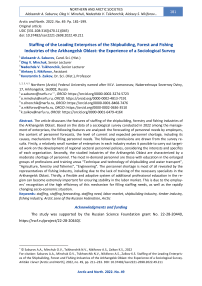Staffing of the Leading Enterprises of the Shipbuilding, Forest and Fishing Industries of the Arkhangelsk Oblast: the Experience of a Sociological Survey
Автор: Saburov A.A., Minchuk O.V., Tsikhonchik N.V., Nikiforov A.S., Zaikov K.S.
Журнал: Arctic and North @arctic-and-north
Рубрика: Northern and arctic societies
Статья в выпуске: 49, 2022 года.
Бесплатный доступ
The article discusses the features of staffing of the shipbuilding, forestry and fishing industries of the Arkhangelsk Oblast. Based on the data of a sociological survey conducted in 2022 among the management of enterprises, the following features are analyzed: the forecasting of personnel needs by employers, the content of personnel forecasts, the level of current and expected personnel shortage, including its causes, mechanisms for filling personnel needs. The following conclusions are drawn from the survey results. Firstly, a relatively small number of enterprises in each industry makes it possible to carry out targeted work on the development of regional sectoral personnel policies, considering the interests and specifics of each organization. Secondly, the studied industries of the Arkhangelsk Oblast are characterized by a moderate shortage of personnel. The most in-demand personnel are those with education in the enlarged groups of professions and training areas “Technique and technology of shipbuilding and water transport”, “Agriculture, forestry and fisheries”, “Engineering”. The personnel shortage is most of all revealed by the representatives of fishing industry, including due to the lack of training of the necessary specialists in the Arkhangelsk Oblast. Thirdly, a flexible and adaptive system of additional professional education in the region can become extremely important for ensuring stability in the labor market. This is due to the employers’ recognition of the high efficiency of this mechanism for filling staffing needs, as well as the rapidly changing socio-economic situation.
Staffing, staffing forecasting, staffing need, labor market, shipbuilding industry, timber industry, fishing industry, Arctic zone of the Russian Federation, Arctic
Короткий адрес: https://sciup.org/148329271
IDR: 148329271 | УДК: [331.108:316](470.11)(045) | DOI: 10.37482/issn2221-2698.2022.49.211
Текст научной статьи Staffing of the Leading Enterprises of the Shipbuilding, Forest and Fishing Industries of the Arkhangelsk Oblast: the Experience of a Sociological Survey
The study was supported by the Russian Science Foundation grant No. 22-28-20440,
In recent decades, global and local labor markets have undergone serious structural transformations associated with a number of long-term trends. These include the reduction of the working-age population, the liberalization of the labor market and, as a consequence, the phenomenon of precarization of employment (decrease in the social protection of workers, the growth of informal and non-standard employment) [1, Kalleberg A.L., p. 258–270; 2, Popov A.V., Solovieva T.S., p. 103–113].
A particularly strong impact on employment and recruitment of labor is caused by automation (replacement of manual labor by electronic computing machines) and digitalization (restruc-turing/renewal of business processes based on the use of digital technologies). These trends are changing the content of work at a high speed, reducing the demand for certain professions and creating new jobs and entire industries [3, Kalleberg A.L., Leicht K.T.]. The COVID-19 pandemic, in turn, has further accelerated the trends associated with the growth of remote employment, digitalization, and the growth of labor relations flexibility [4, Nikitina N.A., p. 125–136].
Staffing issues are undoubtedly relevant for the Arctic zone of the Russian Federation — a strategically important region in terms of providing the country’s economy with natural resources and defense capability. The Arctic macro-region produces 12–15% of the country’s GDP and accounts for about a quarter of Russia’s exports. Population decline, outflow of labor resources, and low replacement of human resources are negative trends that characterize the current state of socio-economic development of municipalities in the Arctic zone of Russia. The Strategy for the development of the Arctic Zone of the Russian Federation and ensuring national security for the period up to 2035 1 states the necessity to bring the system of vocational education and additional education in line with the predicted staffing needs of employers in the economy and social sphere of the Arctic zone of Russia.
The solution to the issue of staffing of a macro-region, especially such a complex one as the Arctic zone of the Russian Federation, is comprehensive, due to the fact that the subjects included in the Russian Arctic differ greatly both in terms of the level of economic development and industries of specialization, as well as the level of development of higher and secondary vocational education (hereinafter — HE and SVE). Thus, the solution to the problem of balancing the labor market in the Russian Arctic is associated with the development of an optimal personnel policy at the level of individual regions and industries.
Approaches to the staffing analysis
Currently, the leading approach to the analysis of staffing is the macroeconomic methodology developed by the Budget Monitoring Center of Petrozavodsk State University (V.A. Gurtov), taking into account foreign experience, which allows forming quantitative indicators of additional staffing requirements of the economy, necessary to ensure the projected production of goods and services. Additional staffing needs are calculated in the context of regions (municipalities), levels of education, professions and specialties [5, Gurtov V.A., p. 130–161]. This methodology is based on statistical data (primarily on the number of employees), as well as estimates of economic growth, labor productivity and projected demographic indicators. The calculation of the projected staffing needs is specified by means of employer surveys on the most demanded professions. The indisputable practical result of applying the macroeconomic methodology is a wide sectoral and territorial coverage, as well as the ability to make decisions on the formation of enrollment targets both at the level of the Ministry of Higher Education and Science of the Russian Federation (higher education) and at the level of subjects of the federation (secondary vocational education). Regarding the Arctic zone of the Russian Federation, a study was carried out in 2020 at the request of the Agency for Human Capital Development in the Far East and the Arctic using this methodology. The data obtained revealed the insufficiency of internal labor resources in the Arctic territories to meet future staffing requirements. The expected staffing demand of the Russian Arctic by 2024 in the amount of 66 thousand people can be provided by a little more than 50% due to graduates of Russian educational institutions, retraining of unemployed citizens and vocational training for those who do not have vocational education.
At the same time, the conducted study does not allow answering a number of questions that are important for analyzing the situation in individual regions and sectors of the Russian Arctic. Firstly, the shortage of which specialists is the most sensitive for employers and to what extent it affects the activity of organizations. Secondly, what competencies of employees are most in demand among enterprises, especially in view of the rapidly developing processes of automation and digitalization and increasing need for the so-called “flexible skills”. Thirdly, to what extent employers use the resource of cooperation with regional educational institutions of higher and secondary vocational education to meet their staffing needs. Finally, how employers’ staffing needs and strategies have evolved in a turbulent socio-economic environment, particularly the disruption caused by the COVID-19 pandemic as well as the Special military operation, followed by Western sanctions and partial mobilization.
In this regard, the use of sociological tools to investigate staffing at the level of individual sectors and regions seems appropriate. Russian and world practice actively uses questionnaires and interviews with employers in order to analyze staffing deficit in enterprises, search and recruitment patterns, satisfaction with quality of graduates training, current and expected shortage
NORTHERN AND ARCTIC SOCIETIES
Aleksandr A. Saburov, Oleg V. Minchuk, Nadezhda V. Tsikhonchik, Aleksey S. Nikiforov… of professional and flexible skills among employees, interaction with educational organizations, training their own employees.
Studies of this nature have been and are being carried out in Russia (Higher School of Economics) [6; 7; 8, Bondarenko N.V], Great Britain (British Employer Skills Survey) [9, Winterbotham M., Kik G., Selner S., Menys R., Stroud S., Whittaker S., Hewitt J.H. ], Ireland (Irish National Employer Survey) 2, USA (The National Employer Survey) [10, Cappelli, p. 635–635; 11, Shapiro D.], Azerbaijan [12, Rutkowski J.] and Cambodia [13, Bruni M., Luch L., Kuoch S.]. The study of de Lar-quier and Marshal [14, De Larquier G., Marchal E., p. 567–589], based on data from a survey of French employers in 2005, classifies the job applicant selection process according to four main types and determines the degree of influence of various types of selection on the discrimination of certain groups of candidates (women, unemployed, applicants without formal education). Recruitment and readiness of employers in the Arctic zone of the Russian Federation to hire job applicants who have received education with the use of distance learning technologies are studied in the work of Zaikov K.S. et al. [15].
Literature review shows that, despite the extensive use of sociological tools to analyze the staffing situation, the specifics of staffing needs, their forecasting and replenishment by employers in certain sectors of the Russian Arctic regions remain unexplored.
Research methodology
Institute for Strategic Development of the Arctic of NArFU named after M.V. Lomonosov conducted an applied sociological study “Personnel support for the shipbuilding, forestry and fishing industries of the Arkhangelsk Oblast in the context of digitalization” in 2022. The study is part of the implementation of the scientific project “Staffing models for the economic sectors of the Russian Arctic regions in the context of digitalization”.
The purpose of the study was to analyze the perceptions of the management of enterprises in the shipbuilding, forestry and fishing industries in the Arkhangelsk Oblast on staffing and strategies to meet the staffing needs of these enterprises.
The survey was conducted by means of electronic questionnaires using LimeSurvey software. The survey was conducted from August 3 to September 6, 2022. The questionnaire included 36 questions divided into three main blocks: 1) forecasting staffing needs; 2) demanded competencies and satisfaction with the level of training of graduates; 3) interaction with educational organizations. The questions related to the subject matter of the article were in the first block. Within this block of questions, the following tasks were set: to assess the level of forecasting by enterprises of their own staffing needs; to study the management’s perception of the current and expected in the short and medium term staffing shortage; to study the measures taken by the management of enterprises to fill the staffing needs.
In this study, the issues of staffing requirements were addressed to the following categories of employees engaged in production units (responsible for the main activities), as well as in functional departments (e.g. accounting, financial, human resources, marketing):
-
• executives and highly qualified specialists;
-
• mid-level specialists, technical staff;
-
• skilled workers.
The following categories of workers were not covered by the survey:
-
• senior managers;
-
• line managers of departments responsible for the main production activities, heads of functional departments (financial, planning, HR services, etc.);
-
• unskilled workers.
The choice was conditioned by the necessity of higher or secondary professional education in certain areas of training. The questionnaire did not address managers and unskilled workers due to the fact that the level of education, training and qualifications are usually not a significant factor in the employment of these categories at the enterprises of specific industries.
The enterprises of shipbuilding, forestry and fishing industries of the Arkhangelsk Oblast were included in the general population of the study, taking into account the main and additional types of economic activity in accordance with the Russian Joint Academic Coding System (Table 1).
Table 1
Types of economic activity
|
Industry |
Types of economic activity |
|
Forestry |
02 Forestry and timber production 16 Woodworking and production of wood and cork products, except furniture, straw products and plaiting materials |
|
Fisheries |
03 Fishing and fish farming 10.2 Processing and preservation of fish, crustaceans and molluscs |
|
Shipbuilding |
25.99.26 Manufacture of ship propellers and paddle wheels 30.1 Construction of ships, vessels and boats 33.15 Repair and maintenance of ships and boats |
The main criterion for selecting the presented industries was their significance for the region’s economy: these industries are among the priorities for the region in accordance with the “Strategy for the socio-economic development of the Arkhangelsk Oblast up to 2035” 3.
The general population of the study was 90 legal entities of various organizational and legal forms. The total number of completed questionnaires is 21, which correspond to 50 enterprises that participated in the survey. The difference in values is explained by the specifics of the survey of employers: several large organizations filled out the questionnaire for their subsidiaries and branches, which are separate legal entities.
All industries are represented in the sample — fishing industry, shipbuilding, and forest industry. The survey covered large (46%) and medium and small (54%) industrial enterprises. Distribution of the surveyed enterprises by the industry is shown in figure 1.
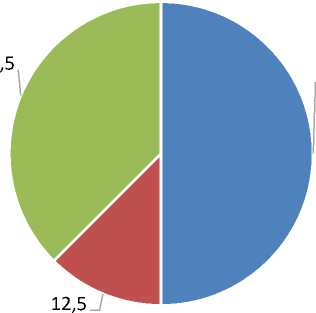
■ Forest ■ Fishery ■ Shipbuilding
Fig. 1. Distribution of the surveyed enterprises by the industry, %.
From the general population of legal entities of each of the industry under consideration, the survey was completed by: the fishing industry — 40% of enterprises; forestry — 64% of enterprises; shipbuilding — 44% of enterprises. In the forest industry, 36 enterprises were surveyed, which employ more than 54% of employees from the entire industry. In the fishing industry, 10 enterprises were surveyed, which employ more than 54% of employees from the entire industry. In the shipbuilding industry, 4 enterprises were surveyed, which employ 93% of employees from the entire industry.
Thus, it can be stated that the survey data meet the representativeness criterion and can be used to evaluate each of the sectors under consideration, respectively 4.
Implementation of staffing forecasting
According to the results of the study, 90.4% of the surveyed enterprises carry out forecasting of staffing needs. At the same time, only 19% carry out this forecasting on the basis of normative documents and requirements developed in the organization. Enterprises which realize forecasting do it mainly in the short-term perspective. Thus, 68.4% of the respondents plan staffing requirements for the period up to 3 years, 26.3% — for the medium term. Only 5.3% are planning for a longer perspective.
Comparison of enterprises by the availability of forecasting in the context of industries and the average number of employees (hereinafter — ANE) makes it possible to draw the following conclusions. All large enterprises (ANE over 250 people) carry out forecasting of personnel needs. In turn, small and medium-sized enterprises (ANE 250 people or less) carry out forecasting of staffing needs to a lesser extent (Fig. 2). Most often, this planning is short-term (up to three years), not regulated by internal documents.
The tendency for large enterprises to prevail over medium-sized and small ones in the context of the availability of staff forecasting seems to be natural. Large enterprises of the Arkhangelsk Oblast, included in the sample of the study, have a large ANE. Thus, leading enterprises, first of all shipbuilding and timber industry, employ more than 10 thousand people, which requires a systematic approach to personnel planning.
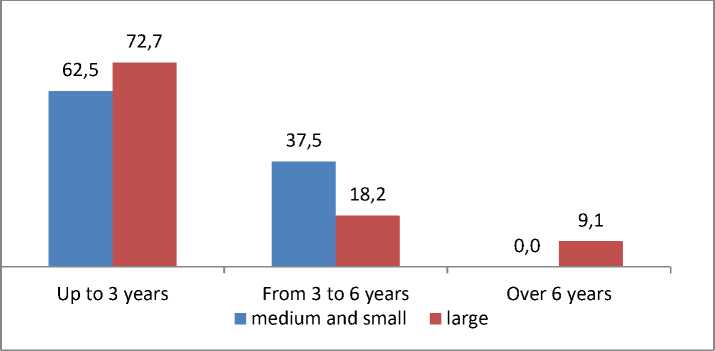
Fig. 2. Term of staffing forecasting at the surveyed enterprises in the context of ANE, %.
The highest share of forecasting staffing needs is demonstrated by companies from the fisheries sector, but they do not have documents regulating it. Only one shipbuilding employer and one timber industry employer reported that they do not forecast staffing requirements. The forecasting of personnel needs regulated by internal normative acts is typical for one large enterprise in the shipbuilding industry and three enterprises in the forestry industry (Fig. 3).

■ Yes, but the forecasting of staffing needs is NOT regulated by the regulatory documents of the enterprise
-
■ Yes, the forecasting of staffing needs is regulated by the regulatory documents of the enterprise
-
■ Forecasting of staffing needs is not carried out
Fig. 3. Staff forecasting by the surveyed enterprises by industries, %.
While most organizations do only short-term planning of staffing needs, one major employer in the shipbuilding industry performs forecasting for a period of more than 6 years. Besides, one shipbuilding organization and 4 forest industry companies carry out forecasting for a period of 3 to 6 years.
100,0
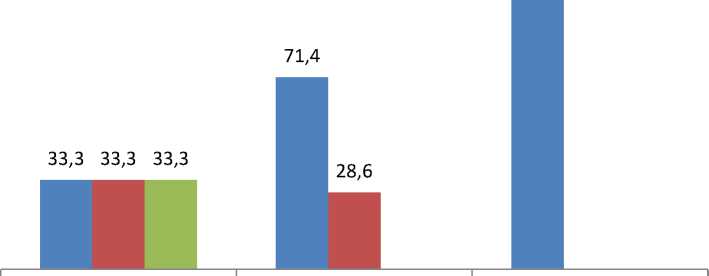
Shipbuilding Forest Fishery
■ Up to 3 years ■ From 3 to 6 years ■ Over 6 years
Fig. 4. Duration of staff forecasting by the surveyed enterprises by industries, %.
The relative majority of surveyed enterprises (57.9%) focus on both the number of employees and the required competencies (Fig. 5). A quarter of the respondents are guided only by the number of employees, another 15% — on competencies that are relevant for the enterprise.
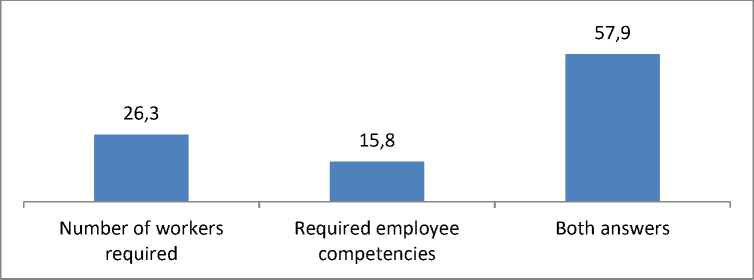
Fig. 5. Content of forecasting the staffing needs of the surveyed enterprises, %.
Enterprises of the fishing industry are more focused on the required competencies of employees than representatives of other sectors (Fig. 6).
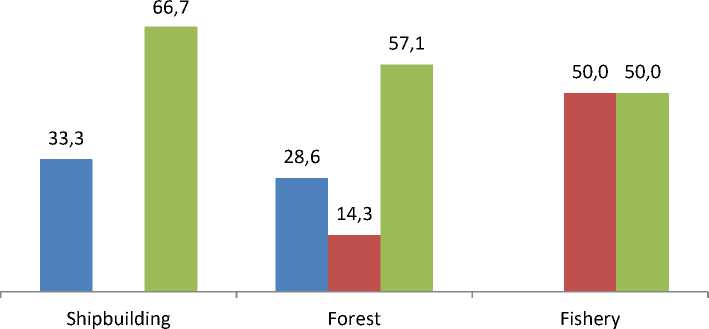
■ Number of workers required ■ Required employee competencies
■ Both answers
Fig. 6. Content of forecasting the staffing needs of the surveyed enterprises by industry, %.
The survey data show that the main objectives of staff forecasting at enterprises are the search for employees in the labor market to fill vacant positions and the planning of retraining and advanced training of employees (Fig. 7). 38.1% of respondents indicated that the results of forecasting form a request for the training of specialists in educational institutions.
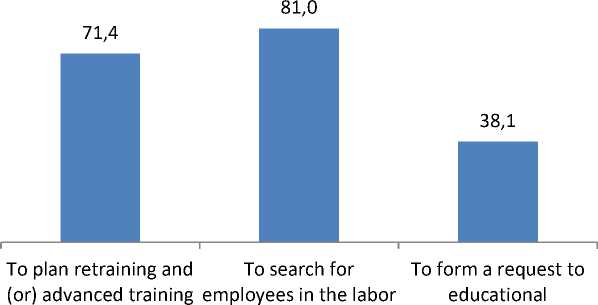
of employees market organizations for the training of specialists
Fig. 7. Personnel forecasting objectives of the surveyed enterprises, %.
It is important to note that the results of forecasting staffing needs in order to form a request to educational organizations are used exclusively by large enterprises of all considered industries (Fig. 8).
90,9 87,5 90,9

To plan retraining and To search for employees To form a request to (or) advanced training in the labor market educational of employees organizations for the training of specialists
-
■ medium and small ■ large
Fig. 8. Goals of staff forecasting of the surveyed enterprises, %.
Level of current and expected staffing deficit
Today, many enterprises are experiencing a shortage of skilled labor, or at least difficulties in finding the necessary specialists.
According to the survey, only one large company in the timber industry is experiencing a serious shortage of personnel. In general, the situation can be characterized as a moderate shortage of personnel: 42.9% of respondents answered this way (Fig. 9). 19% of employers do not feel a shortage of personnel; in particular, this is a large enterprise in the shipbuilding industry, as well as 3 forestry and wood processing enterprises.
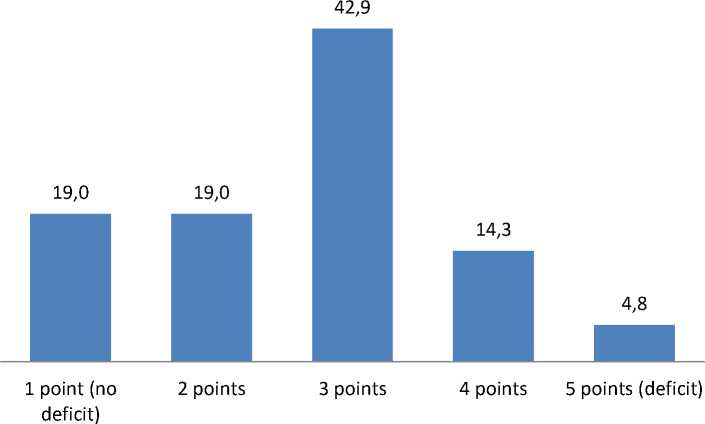
Fig. 9. Estimation of staff shortage by the surveyed enterprises, %.
It is interesting to note that all enterprises of the fishing industry estimate the personnel shortage at an average level (Fig. 10). At the same time, medium and small enterprises have a less pronounced personnel shortage in contrast to large enterprises.

Fig. 10. Estimation of staff shortage by the surveyed enterprises by industries, %.
In order to analyze the most deficient professions indicated by the respondents, they were summarized and compared within the enlarged groups of specialties and areas of training in accordance with the Russian Joint Academic Coding System (RJACS 5). This procedure makes it possible to correlate the real staffing needs of employers with the probable areas of training for these professions. The analysis was conducted in the context of the industries under consideration.
The survey conducted showed that forest industry enterprises are experiencing the greatest shortage of professions (specialties) of workers who require education in the group 2.15.00.00 “Engineering” and 4.35.00.00 “Agriculture, forestry and fisheries”, 30.5% and 31.1% of the total requirement indicated by them, respectively (Fig. 11).

0,6
■ Agriculture, forestry and fisheries
■ Technosphere safety and environmental management
■ Mechanical engineering
■ Industrial ecology and biotechnology
Electric and thermal power engineering
■ Computer and Information Sciences
■ Technique and technology of land transport
0,6
Fig. 11. Distribution of staffing needs by enlarged groups of training areas of the forest industry, %.
Respondents indicated the following professions as the scarcest: a logging and skidding machine operator, a repairman, a mechanic, a forestry foreman, a tractor driver of agricultural production.
-
5 RJACS is used for classification and coding of professions, specialties and areas of training in the implementation of professional educational programs of secondary vocational and higher education.
The fishing industry is experiencing a shortage of personnel, primarily in professions that correspond to the enlarged group 2.26.00.00 “Technique and technology of shipbuilding and water transport” — 70.1% of the total number of declared shortages (Fig. 12). Among these professions, the following should be distinguished: a shipbuilder-ship repairer of metal vessels and a ship mechanic.
70,7

-
■ Agriculture, forestry and fisheries
-
■ Mechanical engineering
-
■ Equipment and technologies for shipbuilding and water transport
-
Fig. 12. Distribution of staffing needs by enlarged groups of training areas of the fishing industry, %.
The largest staffing requirement in absolute terms is stated by shipbuilding industry — over 800 people, which is comparable to the number of several large enterprises. There is a pronounced need for professions that require education in the enlarged group 2.26.00.00 “Technique and technology of shipbuilding and water transport” — 86.2% of the total (Fig. 13). First of all, these are ship electricians, shipbuilders and ship-repairers of metal and non-metal vessels (more than 500 people).
-
7,3 3,8 86,2 0,1 0,1 2,4
-
■ Electronics, radio engineering and communication systems
-
■ Mechanical engineering
-
■ Engineering and technology of shipbuilding and water transport
-
■ Technique and technology of land transport
-
■ Economics and Management
-
■ Technique and construction technology
-
Fig. 13. Distribution of staffing needs by enlarged groups of training areas of the shipbuilding industry, %.
Representatives of enterprises see the causes of staffing shortage mainly in the absence of necessary specialists in the labor market (answer options: “there are no specialists with the re- quired level of qualification in the labor market”, “the required specialists are not fully trained” made up the vast majority of answers). The second most important problem, according to respondents, is the inability to offer competitive working conditions to specialists (Fig. 14).
Other
There are no specialists with the required level 61,9 14,3
of qualification in the labor market

14,3
Educational organizations in the region do not train the required specialists
Inability to offer 42,9 specialists competitive
33,3
The training of the required specialists is
working conditions
not carried out in full
Fig. 14. Reasons of staff shortage at the enterprises.
Respondents of the fishing industry, to the greatest extent compared with other industries, stated both the absolute shortage of demanded specialists and the fact that the educational organizations of the region do not provide training in the necessary specialties (Fig. 15).
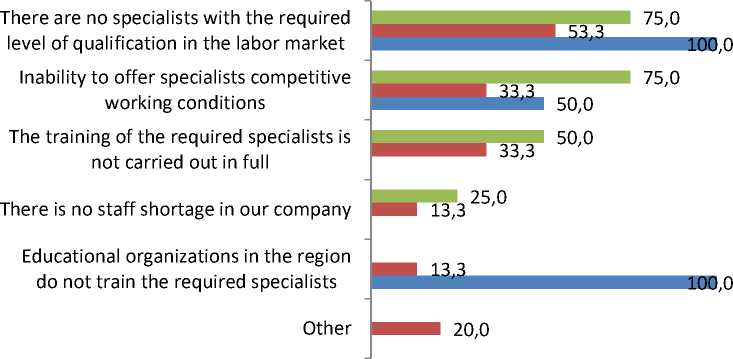
■ Shipbuilding ■ Forest ■ Fishery
Fig. 15. Reasons of staff shortage at the enterprises, %.
Level of expected staff shortage
The more distant the planning horizon is, the less certain the respondents’ assessments of the expected staffing needs are. Thus, the share of those who found it difficult to answer within the 3-year planning perspectives was 10%, and within the 6-year planning — already 43% (Fig. 16). Nevertheless, both in the near future and in the long term, representatives of enterprises predict a staff shortage. In the perspective of 3-year planning, 52% of respondents expect a shortage of personnel at their enterprises.
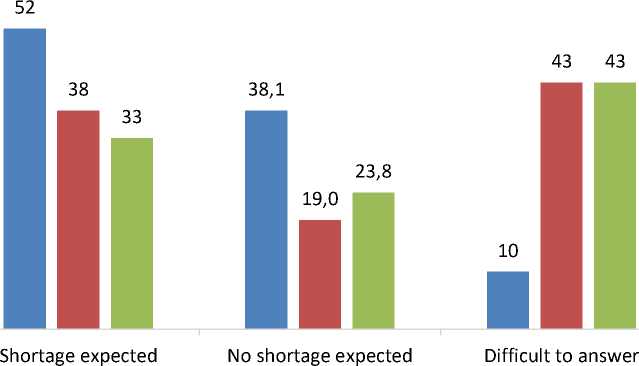
■ In perspective 3 years
■ In the future from 3 to 6 years
-
■ In perspective from 6 years
Fig. 16. Level of staff shortage expected by enterprises, %.
The largest shortage in the short term perspective is expected at the enterprises of the fishing industry, which corresponds to the previous data on assessing the state of the staff short- age (Fig. 17).
50 50 50 50
47 47

Shortage No shortage Difficult to expected expected answer
Shortage No shortage Difficult to expected expected answer
Shipbuilding
Forest
Shortage expected

No shortage Difficult to expected answer
Fishery
■ In perspective 3 years
-
■ In the future from 3 to 6 years ■ In perspective from 6 years
-
Fig. 17. Level of staff shortage expected by enterprises by industries, %.
Mechanisms for filling staffing needs
In order to solve the problem of staff shortage, the surveyed enterprises actively use a wide range of tools, including open publications in the Internet and mass media, retraining employees on their own, using personal connections, attracting resources of educational organizations (industrial practice of students and staff retraining) (Fig. 18). Target training (indicated by 61.9% of respondents) and private recruitment agencies (38.1%) are the least popular among the proposed methods.
Contacts private recruitment
agencies
Advertises in newspapers, radio, television, the Internet,
etc.
Carries out retraining and advanced training of 90
employees on the basis of educational organizations of the Arkhangelsk region
38,1
61,9
Allocates funds for targeted training under programs of secondary vocational and (or) higher education
Participates in career days and similar events
Takes students to practice with the prospect of subsequent employment 90,5
71,4
Carries out retraining and advanced training of employees is mainly carried out on the basis of educational organizations in other regions and abroad
Apply to the State
Employment Service 85,7
Carries out retraining an advanced training of employees on its own (including corporate structures)
85,7
Directly applies to organizations of secondary vocational and higher education to attract
promising students
Looking for with the help of 85, colleagues, acquaintances
-
Fig. 18. Ways of filling the staffing needs of the surveyed enterprises.
The frequency of using tools to fill staffing needs generally corresponds to the assessment of their effectiveness (Table 2). According to respondents, the following measures have the greatest effect: retraining and advanced training of employees on their own; advertisements in newspapers, radio, TV, the Internet, etc.; search with the help of colleagues, acquaintances; application to secondary and higher educational institutions to attract promising students; retraining and advanced training of employees on the basis of educational organizations of the Arkhangelsk Oblast. Respondents consider the public employment service and private employment agencies to be the least efficient ways to get new employees, as well as the allocation of funds for targeted training.
Table 2
Evaluation of the effectiveness of mechanisms for filling staffing needs by enterprises, % (the answer “this mechanism is not used” is not included in the table)
|
Mechanism for filling staffing needs |
Completely ineffective or ineffective |
Moderate efficiency |
Effective and very effective |
|
Retraining and advanced training of employees on its own (including corporate structures) |
9.5 |
9.5 |
66.7 |
|
Retraining and advanced training of employees on the basis of educational organizations of the Arkhangelsk Oblast |
9.5 |
19 |
61.9 |
|
Advertisements in newspapers, on radio, television, on the Internet, etc. |
19.1 |
23.8 |
57.1 |
|
Help of colleagues, acquaintances |
14.3 |
14.3 |
57.1 |
|
Appeals directly to organizations of secondary vocational and higher education to attract promising students |
23.8 |
9.5 |
47.6 |
|
Practice of students with the prospect of subsequent employment |
23.8 |
23.8 |
42.9 |
|
Career days and similar events |
19.1 |
9.5 |
42.9 |
|
Retraining and advanced training of employees (mainly on the basis of educational organizations in other regions and abroad) |
14.3 |
23.8 |
33.3 |
|
Public employment service |
28.6 |
28.6 |
28.6 |
|
Allocation of funds for targeted training under programs of secondary vocational and (or) higher education |
19 |
19 |
23.8 |
|
Private recruiting agencies |
19.1 |
9.5 |
9.6 |
The enterprises search for job applicants not only in the Arkhangelsk Oblast, but also outside the region. Thus, half of the respondents search for workers in other regions of Russia (none of the respondents chose the option of searching abroad). The following professions are searched by enterprises in other regions of the Russian Federation: a ship pipe fitter, a ship fitter, a metallurgical engineer, a turner-bore operator, an electrician, a ship electrician, a taxator, a forest fund specialist, a forest fund allotment foreman, shipboard personnel specialists. This list generally corresponds to the most demanded professions, for which employers have indicated a staff shortage.
Conclusion
The conducted research allows a number of conclusions to be drawn regarding the staffing situation in the shipbuilding, fishing and forestry industries in the Arkhangelsk Oblast.
-
1. The bulk of workers employed in these industries are concentrated at large enterprises (their branches, subsidiaries). In the context of regional labor market development, it has positive consequences, as it allows realizing targeted work on development of regional sectoral personnel policies, taking into account the interests and specifics of each organization. At the same time, the reverse side of this situation is the potential vulnerability of the regional labor market in case of significant staff reductions of major players.
-
2. In general, the situation in the three studied sectors of the Arkhangelsk Oblast can be characterized as a moderate staffing shortage. The greatest shortage of personnel is observed in specialists in enlarged groups of training areas and specialties “Technique and technology of shipbuilding and water transport”, “Agriculture, forestry and fisheries”, “Mechanic engineering”. The shortage of personnel is most noted by representatives of the fishing industry, who forecast a shortage of personnel in the perspective of three years. All the representatives of the fishing industry actualized the problem of the lack of necessary specialists training in the Arkhangelsk Oblast.
-
3. Despite the fact that most of the surveyed organizations carry out forecasting taking into account the quantitative and competence characteristics of the workforce, this forecasting in absolute majority of cases extends to short-term perspective due to unstable socio-economic situation. In this regard, a flexible and adaptive system of additional vocational education in the region can become of great importance for ensuring stability in the labor market. Its role is emphasized by the fact that the majority of employers indicated retraining and advanced training of employees both on their own and on the basis of educational organizations of the Arkhangelsk Oblast as the most effective tools for filling the staffing needs.
The revealed tendencies determine the necessity of subsequent surveys of employers regarding the competencies that are in demand and interaction with educational organizations. The objectives of this study are to continue and deepen the data by conducting in-depth interviews with managers and experts in these sectors, who will clarify the content of staffing forecast of enterprises and its impact on decision-making in the staffing sphere, the impact of the lack of specialists of different professions on the activities of the company and other aspects of staffing.
Список литературы Staffing of the Leading Enterprises of the Shipbuilding, Forest and Fishing Industries of the Arkhangelsk Oblast: the Experience of a Sociological Survey
- Kalleberg A.L. Labor Market Uncertainties and Youth Labor Force Experiences: Lessons Learned. The Annals of the American Academy of Political and Social Science, 2020, vol. 688, iss. 1, pp. 258–270. DOI: 10.1177/0002716220913861
- Popov A.V., Soloveva T.S. Prekarizatsiya zanyatosti: analiz nauchnogo diskursa o sushchnosti i vektorakh izmereniya [Employment Precarization: Discussion on the Essence and Ways of Measur-ing]. Sotsiologicheskie issledovaniya [Sociological Studies], 2020, no. 9, pp. 103–113. DOI: 10.31857/S013216250009618-2
- Kalleberg A.L., Leicht K.T. United States: Eight Key Themes in Sociology of Work. La Nouvelle Revue du Travail, 2021, no. 19. DOI: 10.4000/nrt.10168
- Nikitina N.A. Izmeneniya na rynkakh truda v usloviyakh pandemii [Labour Market Changes in the Face of Pandemic]. Sotsial'nye i ekonomicheskie sistemy [Social and Economic Systems], 2020, no. 3, pp. 125–136.
- Gurtov V.A., Pitukhin E.A. Prognozirovanie potrebnostey ekonomiki v kvalifitsirovannykh kadrakh: obzor podkhodov i praktik primeneniya [Prognostication of the Demands of Economics in Qualified Personnel: Review of Approaches and Application Experience]. Universitetskoe upravlenie: praktika i analiz [Journal University Management: Practice and Analysis], 2017, vol. 21, no. 4 (110), pp. 130–161. DOI: 10.15826/umpa.2017.04.056
- Bondarenko N.V. Obrazovatel'nye organizatsii, realizuyushchie programmy srednego profession-al'nogo obrazovaniya, na rynke obrazovatel'nykh uslug. Informatsionnyy byulleten' [Educational Or-ganizations Implementing Programs of Secondary Vocational Education in the Market of Education-al Services. News Bulletin]. Moscow, National Research University Higher School of Economics Publ., 2017, no. 20 (119), 36 p.
- Bondarenko N.V. Analiz vzaimodeystviya sistemy srednego professional'nogo obrazovaniya i rabo-todateley vysokotekhnologichnykh sektorov ekonomiki. Informatsionnyy byulleten' [Analysis of the Interaction between the System of Secondary Vocational Education and Employers in High-Tech Sectors of the Economy. News Bulletin]. Moscow, National Research University Higher School of Economics Publ., 2018, no. 2 (122), 32 p.
- Bondarenko N.V. Analiz vzaimodeystviya sistemy srednego professional'nogo obrazovaniya i rabo-todateley, ispol'zuyushchikh trud rabotnikov massovykh professiy i spetsial'nostey. Informatsionnyy byulleten' [Analysis of the Interaction between the System of Secondary Vocational Education and Employers Using the Labor of Workers of Mass Professions and Specialties. News Bulletin]. Mos-cow, National Research University Higher School of Economics Publ., 2017, no. 6 (105), 48 p.
- Winterbotham M., Kik G., Selner S., Menys R., Stroud S., Whittaker S., Hewitt J.H. Employer Skills Survey 2019: UK (Excluding Scotland) Findings, 2020.
- Cappelli P. The National Employer Survey: Employer Data on Employment Practices. Industrial Rela-tions, 2001, vol. 40, iss. 4, pp. 635–635. DOI: 10.1111/0019-8676.00230
- Shapiro D. School-to-Work Partnerships and Employer Participation: Evidence on Persistence and At-trition from the National Employer Survey (No. 2-10). National Center for Postsecondary Improve-ment, Stanford University, School of Education, 1999, 42 p.
- Rutkowski J. Demand for Skills: Main Results of the Azerbaijan STEP Employer Survey. Washington, DC, World Bank Group, 2015, 10 p.
- Bruni M., Luch L., Kuoch S. Skills Shortages and Skills Gaps in the Cambodian Labour Market: Evi-dence from Employer Skills Needs Survey. ILO Asia-Pacific Working Paper Series. Geneva, Interna-tional Labour Organization, 2013, 101 p.
- De Larquier G., Marchal E. Does the Formalization of Practices Enhance Equal Hiring Opportunities? An Analysis of a French Nation-Wide Employer Survey. Socio-Economic Review, 2016, no. 14 (3), pp. 567–589.
- Zaikov K.S., Saburov A.A., Tamitskiy A.M., Nikiforov A.S. Online Education in the Russian Arctic: Em-ployers’ Confidence and Educational Institutions’ Readiness. Sustainability, 2021, no. 13 (12), p. 6798. DOI: 10.3390/su13126798

